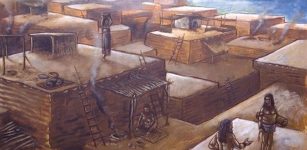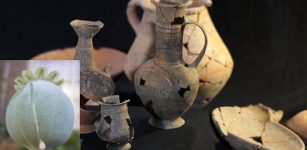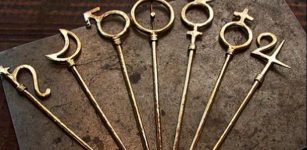Zawgyi – Demi-God And Alchemist With Miraculous Powers In Burmese Mythology And Folklore
A. Sutherland - AncientPages.com - Zawgyi is a semi-immortal human alchemist and mystic with supernatural powers. Traditionally he carries attributes like a red hat and magic, a three-pronged walking stick called Trituli (similar to 'Trishula' (Sanskrit for "triple-spear"), a mysterious symbol of great importance in India.
Mysterious Nariphon tree - Thai lacquerwork painting of the Nariphon tree at Phra Pathom Ched. Image credit: LigerCommon - Public Domain
Being one of the supernatural figures in Burmese mythology and folklore, Zawgyi remains a popular figure in ancient traditions.
As a magician, Zawgyi can do many unbelievable things. He can disappear or fly like a bird in the sky, take a tour to the moon, travel beneath the Earth, oceans and perform necromancy, divination, and resurrection as well.
This legendary invisible forest surrounds the base of Mount Meru. This forest is the home of several mythical creatures, such as Naga, Kinnara, Apsonsi, Gilen, Zawgyi, and Garuda. In Buddhist and Hindu mythology, Zawgyi has roots in pre-Buddhist Burma and dwells alone in Himavanta. He spends much time searching for herbs for magical purposes and longevity and specific herbs to help eliminate people's suffering.
What is unique about him is that he has never been associated with women but only with males. Sometimes, however, Zawgyi does unbelievable wonders with a touch of his magic wand. He brings to life "illusory females" from Nariphon (Naripon), a unique fruit tree bearing female-shaped fruits, to fulfill his physical and sexual appetites.
Zawgyi statue at Shwedagon Pagoda. Image credit: Mydaydream89 - CC BY-SA 3.0
Zawgyi- an alchemist, wants to achieve many accomplishments with his supernormal powers. These include immortal life and the timeless state of the Weizza that awaits the appearance of the future Buddha, Maitreya (or Metteya). According to Buddhist tradition, Maitreya will appear on Earth in the future.
Ancient scriptures say that Maitreya will be a successor to the present Buddha, Gautama Buddha. The prophecy announcing Maitreya's arrival refers to a time in the future when the dharma (that means duties, rights, laws, conduct, virtues, and "right way of living.") will have been forgotten by most in the world.
The name 'Zawgyi¨' that belongs to this mysterious, ancient alchemist, means practicing yoga. It derives from the Pali-Sanskrit, the two closely related languages, but the ancient Pali is not considered a descendant of the Sanskrit language.
Many paintings and sculptures reflect Zawgyi's appearance that can still be seen both on stage and in puppetry, a very ancient form of theatre first recorded in the 5th century BC in ancient Greece. However, the puppetry performance originated as long ago as 4000 years ago and developed in different variations in many places around the world, especially in Japan, China, Germany, Indonesia, to name a few.
Zawgyi belongs to one of the unique kinds of puppetry, which is 4000 years old art, widely known worldwide.
In Burma (or Myanmar), puppet plays have been performed since at least the 1400s. In the 1700s, the country's royal court began to formally sponsor and regulate the puppet theater, which contributed to its quick and successful performance with a good reputation. In the 1800s, the so-called 'puppet theater' was considered the most highly developed entertainment art and was also the most popular.
Though no longer as popular today, the tradition is still maintained by a small number of performing troupes.
A Burmese puppet troupe includes puppet handlers, vocalists, and musicians. It has changed very little since it was first introduced to Myanmar or Burma (a country in Southeast Asia) as early as the 15th century, probably from southern China. It is said that Myanmar puppet culture began in the 11th century, more than a thousand years ago. No matter the performance's authenticity, the puppet show has become an amusing activity of the Burmese palace aristocrats.
Burmese puppet show culture has existed for at least 600 years, and as it can be performed at the high stage, it is known as "high drama," and the same characters remain in use today and are very popular.
Written by – A. Sutherland - AncientPages.com Senior Staff Writer
Copyright © AncientPages.com All rights reserved. This material may not be published, broadcast, rewritten or redistributed in whole or part without the express written permission of AncientPages.com
Expand for referencesMore From Ancient Pages
-
 Unusual High-Tech Machine In The Bible Offers Evidence Of Lost Ancient Advanced Civilization
Biblical Mysteries | Aug 18, 2018
Unusual High-Tech Machine In The Bible Offers Evidence Of Lost Ancient Advanced Civilization
Biblical Mysteries | Aug 18, 2018 -
 Huge Viking Hall From Harald Bluetooth’s Time Discovered In North Jutland
Archaeology | Dec 22, 2022
Huge Viking Hall From Harald Bluetooth’s Time Discovered In North Jutland
Archaeology | Dec 22, 2022 -
 On This Day In History: Treaty of Calais Ratified Between France And England – On Oct 24, 1360
News | Oct 24, 2016
On This Day In History: Treaty of Calais Ratified Between France And England – On Oct 24, 1360
News | Oct 24, 2016 -
 Knowledge Of Ancient Medicine Hidden In Undeciphered Egyptian Manuscripts
Archaeology | Aug 16, 2018
Knowledge Of Ancient Medicine Hidden In Undeciphered Egyptian Manuscripts
Archaeology | Aug 16, 2018 -
 Çatalhöyük – 9,000 Years Ago: Overcrowding, Infectious Diseases, Violence And Environmental Problems Of Early Farmers
Archaeology | Jun 18, 2019
Çatalhöyük – 9,000 Years Ago: Overcrowding, Infectious Diseases, Violence And Environmental Problems Of Early Farmers
Archaeology | Jun 18, 2019 -
 Extraordinary 5,000-Year-Old Astronomical Event Depicted On Indian Rock Carving
Archaeoastronomy | Jan 9, 2018
Extraordinary 5,000-Year-Old Astronomical Event Depicted On Indian Rock Carving
Archaeoastronomy | Jan 9, 2018 -
 Does A Baffling Artifact Offer Evidence Of Ancient Extraterrestrial Visitation In New Zealand? – Experts Investigate – Part 2
Featured Stories | Jul 23, 2020
Does A Baffling Artifact Offer Evidence Of Ancient Extraterrestrial Visitation In New Zealand? – Experts Investigate – Part 2
Featured Stories | Jul 23, 2020 -
 On This Day In History: Gutenberg Prints The First Bible – On Feb 23, 1455
News | Feb 23, 2017
On This Day In History: Gutenberg Prints The First Bible – On Feb 23, 1455
News | Feb 23, 2017 -
 Opium Residue Discovered In 3,500-Year-Old Pottery Offers Evidence The Drug Was Used In Ancient Burial Rituals
Archaeology | Sep 20, 2022
Opium Residue Discovered In 3,500-Year-Old Pottery Offers Evidence The Drug Was Used In Ancient Burial Rituals
Archaeology | Sep 20, 2022 -
 Suomenlinna Fortress: Impressive ‘Castle Of Finland’ Has Rich History
Featured Stories | Feb 13, 2016
Suomenlinna Fortress: Impressive ‘Castle Of Finland’ Has Rich History
Featured Stories | Feb 13, 2016 -
 How Was The Mysterious Menga Dolmen Built By Neolithic People? New Scientific Theory Presented
Archaeology | Aug 28, 2024
How Was The Mysterious Menga Dolmen Built By Neolithic People? New Scientific Theory Presented
Archaeology | Aug 28, 2024 -
 Medieval Manor Of Court De Wyck – Re-Discovered
Archaeology | Oct 10, 2023
Medieval Manor Of Court De Wyck – Re-Discovered
Archaeology | Oct 10, 2023 -
 Five Ancient Mirror Frames, Ceramics Factory Found In Intriguing Roman Villa In Pavlikeni, Bulgaria
Archaeology | Mar 13, 2018
Five Ancient Mirror Frames, Ceramics Factory Found In Intriguing Roman Villa In Pavlikeni, Bulgaria
Archaeology | Mar 13, 2018 -
 Ancient Secrets Of Sacred Lismore – Is There A ‘Second’ Iona In Scotland?
Archaeology | Jul 4, 2017
Ancient Secrets Of Sacred Lismore – Is There A ‘Second’ Iona In Scotland?
Archaeology | Jul 4, 2017 -
 Secrets Of Ancient Underwater City Pavlopetri Revealed – Travel Back In Time And See What The City Looked Like!
Archaeology | Mar 1, 2014
Secrets Of Ancient Underwater City Pavlopetri Revealed – Travel Back In Time And See What The City Looked Like!
Archaeology | Mar 1, 2014 -
 Legend Of Brigadoon: Mythical Village Where Time Stands Still
Featured Stories | Nov 2, 2016
Legend Of Brigadoon: Mythical Village Where Time Stands Still
Featured Stories | Nov 2, 2016 -
 Long-Lost Artifact Re-Discovered In Michigan Offers Evidence Of Overseas Visitors In Pre-Columbian Times
Legends And Mysteries Of North America | Jul 16, 2024
Long-Lost Artifact Re-Discovered In Michigan Offers Evidence Of Overseas Visitors In Pre-Columbian Times
Legends And Mysteries Of North America | Jul 16, 2024 -
 Number ‘Seven’: Mystical Number Of The Universe And One Of The Most Sacred Numbers
Ancient Symbols | Feb 14, 2017
Number ‘Seven’: Mystical Number Of The Universe And One Of The Most Sacred Numbers
Ancient Symbols | Feb 14, 2017 -
 Stone Toilet Of A First Temple Period Luxury Villa Reveals The Jerusalem Elite Suffered From Infectious Disease
Archaeology | Jan 4, 2022
Stone Toilet Of A First Temple Period Luxury Villa Reveals The Jerusalem Elite Suffered From Infectious Disease
Archaeology | Jan 4, 2022 -
 Time Capsule: Sunken Ancient City Of Baiae
Archaeology | Mar 27, 2014
Time Capsule: Sunken Ancient City Of Baiae
Archaeology | Mar 27, 2014


